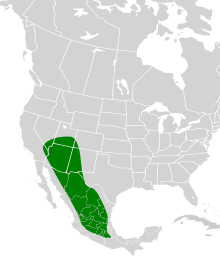Allen's big-eared bat
Allen's big-eared bat (Idionycteris phyllotis) is a species of vesper bat in the monotypic genus Idionycteris. It occurs in Mexico and in Arizona, California, Nevada, New Mexico, Utah, and Colorado[2] in the United States.[1]
| Allen's big-eared bat | |
|---|---|
| Scientific classification | |
| Kingdom: | Animalia |
| Phylum: | Chordata |
| Class: | Mammalia |
| Order: | Chiroptera |
| Family: | Vespertilionidae |
| Genus: | Idionycteris Anthony, 1923 |
| Species: | I. phyllotis |
| Binomial name | |
| Idionycteris phyllotis G.M. Allen, 1916 | |
 | |
Description
Idionycteris is a bat with large ears, weighing 8 to 16 grams. On the dorsal side they possess long and soft pelage,[3] also referred to as fur. Their fur is basally blackish in color with tips that are a yellow-gray color. Idionycteris, has a black patch on each shoulder, a tuft of white hair on the backside of the ears, as well as, ventral hairs that are black with pale tips.[3] The calcar possesses a low keel. The uropatagium has 12 to 13 transverse ribs. The rostrum is flattened and broad.[3]
Idionycteris phyllotis has an external morphology like that of gleaning bats, which means they have adaptions required for plucking stationary insects from surfaces.[3] To do this, they have long tragi and ears, wings adapted for maneuverability and hovering flight, and a gracile jaw.[3] Allen’s big-eared bat (Idionycteris phyllotis) is the only species in North America known to emit long, constant frequency-frequency modulated echolocation calls.[2]
Range and habitat
The Allen’s big-eared bat inhabits the southwestern mountainous regions of Mexico and the United States. This species, occupies a wider range in elevation, ranging from 855 m to 3,225 m, while most specimens reside at altitudes between 1,100 m and 2,500 m.[3]
References
- Arroyo-Cabrales, J. & Ticul Alvarez Castaneda, S. (2008). "Idionycteris phyllotis". IUCN Red List of Threatened Species. 2008. Retrieved 7 February 2010.CS1 maint: ref=harv (link)
- Hayes, M. A., et al. (2009). Allen's big-eared bat (Idionycteris phyllotis) documented in Colorado based on recordings of its distinctive echolocation call. Archived 2016-03-04 at the Wayback Machine The Southwestern Naturalist 54(4), 499-501.
- Czaplewski, Nicholas J. (1983-12-15). "Idionycteris phyllotis". Mammalian Species (208): 1–4. doi:10.2307/3503999. ISSN 0076-3519. JSTOR 3503999.
